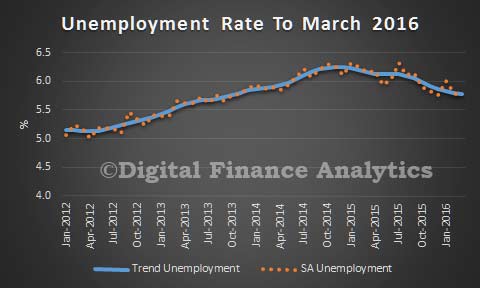The ABS released the labour force data to March 2016. The trend unemployment rate remained at 5.8%, while the seasonally adjusted rate fell to 5.7%. This is a better result than expected by the market.
 However, the ABS says trend employment growth in Australia eased from the relatively strong growth seen in late 2015.
However, the ABS says trend employment growth in Australia eased from the relatively strong growth seen in late 2015.
In March 2016, the annual trend employment growth rate was 2.2 per cent, down from 2.6 per cent in December 2015 . That’s an increase of around 250,000 persons employed, compared with 300,000 persons.
“In March 2016, the trend employment to population ratio remained at 61.2 per cent. This reflects an increase over the year from 60.8 per cent to 61.2 per cent, while over the same period the unemployment rate decreased from 6.2 per cent to 5.8 per cent,” General Manager of ABS’ Macroeconomic Statistics Division, Bruce Hockman said.
Over the past month, trend employment increased by 7,700 persons to 11,910,000 persons, which equated to a monthly growth rate of 0.10 per cent. This monthly growth rate was below the monthly average over the past 20 years (0.15 per cent), and down from the rate of 0.25 per cent in September 2015.
The trend monthly hours worked in all jobs series decreased by 1.8 million hours (0.11 per cent) to 1,643.7 million hours.
The trend series smooth the more volatile seasonally adjusted estimates and provide the best measure of the underlying behaviour of the labour market.
The seasonally adjusted number of persons employed increased by 26,100 in March 2016, while the number of persons unemployed decreased by 7,300. The seasonally adjusted unemployment rate for March 2016 was 5.7 per cent (down 0.1 percentage points) and the seasonally adjusted labour force participation rate remained at 64.9 per cent.
